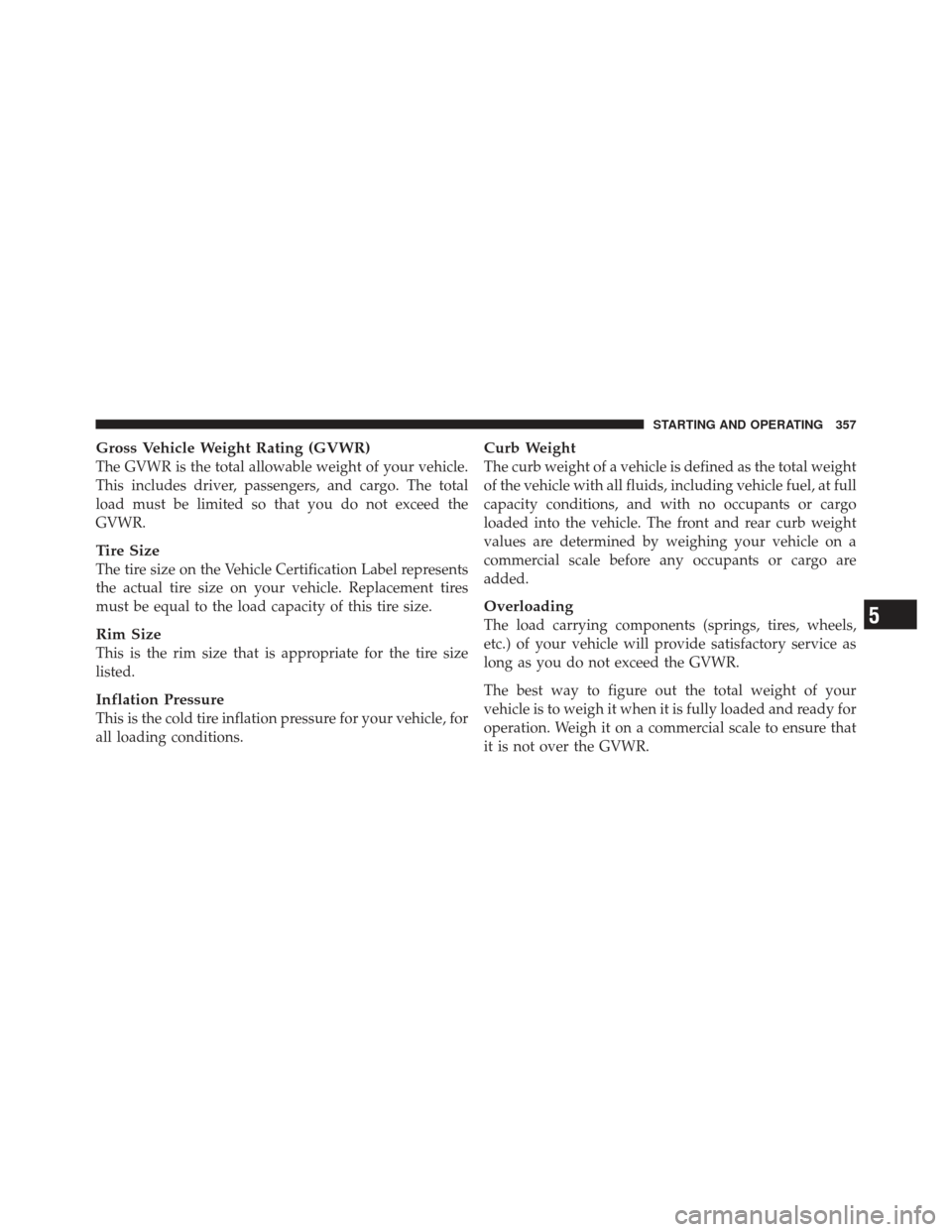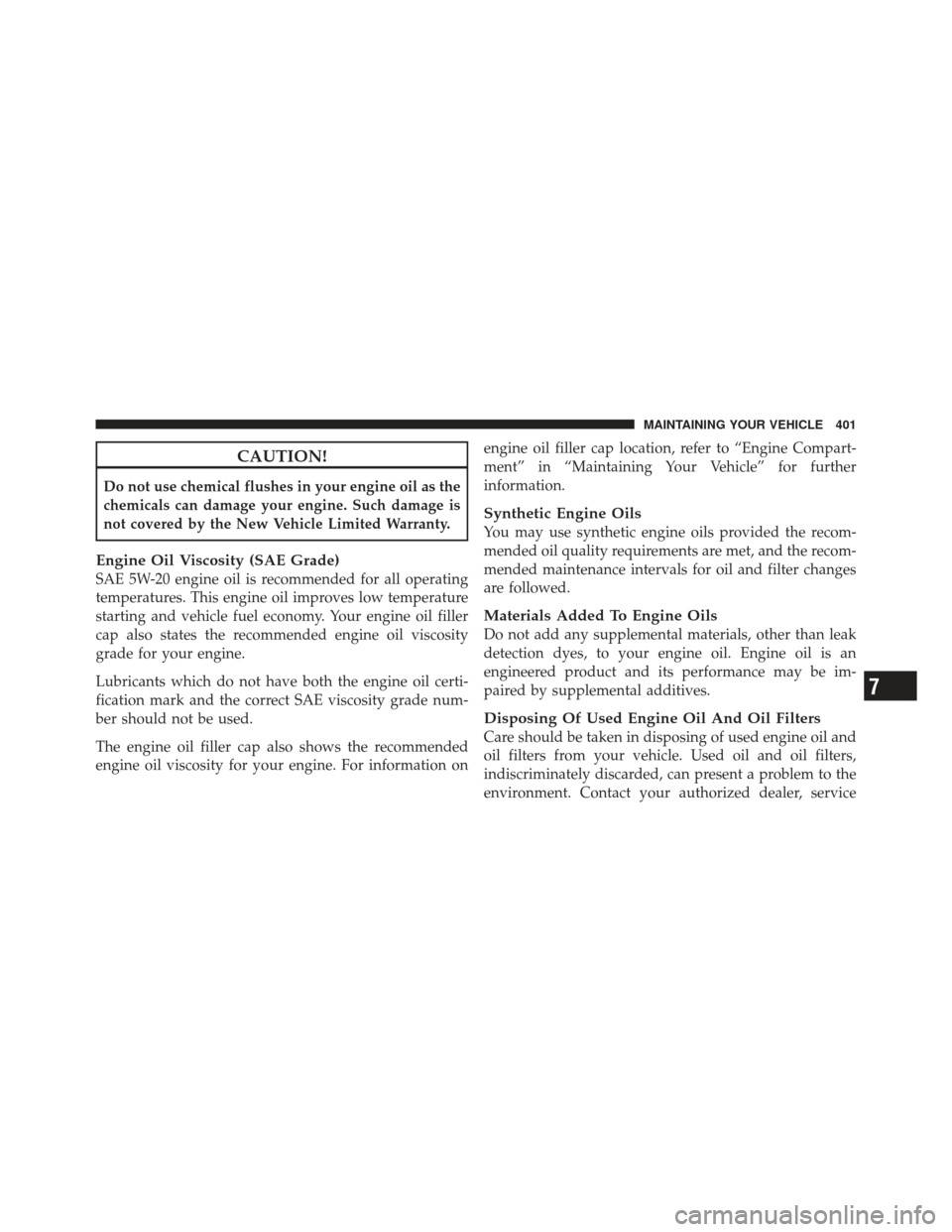Page 359 of 486

Gross Vehicle Weight Rating (GVWR)
The GVWR is the total allowable weight of your vehicle.
This includes driver, passengers, and cargo. The total
load must be limited so that you do not exceed the
GVWR.
Tire Size
The tire size on the Vehicle Certification Label represents
the actual tire size on your vehicle. Replacement tires
must be equal to the load capacity of this tire size.
Rim Size
This is the rim size that is appropriate for the tire size
listed.
Inflation Pressure
This is the cold tire inflation pressure for your vehicle, for
all loading conditions.
Curb Weight
The curb weight of a vehicle is defined as the total weight
of the vehicle with all fluids, including vehicle fuel, at full
capacity conditions, and with no occupants or cargo
loaded into the vehicle. The front and rear curb weight
values are determined by weighing your vehicle on a
commercial scale before any occupants or cargo are
added.
Overloading
The load carrying components (springs, tires, wheels,
etc.) of your vehicle will provide satisfactory service as
long as you do not exceed the GVWR.
The best way to figure out the total weight of your
vehicle is to weigh it when it is fully loaded and ready for
operation. Weigh it on a commercial scale to ensure that
it is not over the GVWR.5
STARTING AND OPERATING 357
Page 393 of 486
MAINTAINING YOUR VEHICLE
CONTENTS
�Engine Compartment — 2.0L ............. 393
� Engine Compartment — 2.4L ............. 394
� Onboard Diagnostic System — OBD II ...... 395
▫ Loose Fuel Filler Cap Message ........... 395
� Emissions Inspection And Maintenance
Programs ............................ 396
� Replacement Parts ..................... 397
� Dealer Service ........................ 398 �
Maintenance Procedures ................. 398
▫ Engine Oil ......................... 399
▫ Engine Oil Filter ..................... 402
▫ Engine Air Cleaner Filter ............... 402
▫ Maintenance-Free Battery .............. 403
▫ Air Conditioner Maintenance ............ 404
▫ Body Lubrication .................... 405
▫ Windshield Wiper Blades ............... 406
▫ Adding Washer Fluid ................. 406
7
Page 397 of 486

ONBOARD DIAGNOSTIC SYSTEM — OBD II
Your vehicle is equipped with a sophisticated onboard
diagnostic system called OBD II. This system monitors
the performance of the emissions, engine, and automatic
transmission control systems. When these systems are
operating properly, your vehicle will provide excellent
performance and fuel economy, as well as engine emis-
sions well within current government regulations.
If any of these systems require service, the OBD II system
will turn on the “Malfunction Indicator Light” (MIL). It
will also store diagnostic codes and other information to
assist your service technician in making repairs. Al-
though your vehicle will usually be drivable and not
need towing, see your authorized dealer for service as
soon as possible.CAUTION!
•Prolonged driving with the MIL on could cause
further damage to the emission control system. It
could also affect fuel economy and drivability. The
vehicle must be serviced before any emissions
tests can be performed.
•If the MIL is flashing while the engine is running,
severe catalytic converter damage and power loss
will soon occur. Immediate service is required.
Loose Fuel Filler Cap Message
After fuel is added, the vehicle diagnostic system can
determine if the fuel filler cap is possibly loose or
improperly installed. A “gASCAP” message will be dis-
played in the instrument cluster. Tighten the gas cap until
a�clicking� sound is heard. This is an indication that the
gas cap is properly tightened. Press the trip odometer
RESET button to turn off the message. If the problem
7
MAINTAINING YOUR VEHICLE 395
Page 403 of 486

CAUTION!
Do not use chemical flushes in your engine oil as the
chemicals can damage your engine. Such damage is
not covered by the New Vehicle Limited Warranty.
Engine Oil Viscosity (SAE Grade)
SAE 5W-20 engine oil is recommended for all operating
temperatures. This engine oil improves low temperature
starting and vehicle fuel economy. Your engine oil filler
cap also states the recommended engine oil viscosity
grade for your engine.
Lubricants which do not have both the engine oil certi-
fication mark and the correct SAE viscosity grade num-
ber should not be used.
The engine oil filler cap also shows the recommended
engine oil viscosity for your engine. For information onengine oil filler cap location, refer to “Engine Compart-
ment” in “Maintaining Your Vehicle” for further
information.
Synthetic Engine Oils
You may use synthetic engine oils provided the recom-
mended oil quality requirements are met, and the recom-
mended maintenance intervals for oil and filter changes
are followed.
Materials Added To Engine Oils
Do not add any supplemental materials, other than leak
detection dyes, to your engine oil. Engine oil is an
engineered product and its performance may be im-
paired by supplemental additives.
Disposing Of Used Engine Oil And Oil Filters
Care should be taken in disposing of used engine oil and
oil filters from your vehicle. Used oil and oil filters,
indiscriminately discarded, can present a problem to the
environment. Contact your authorized dealer, service
7
MAINTAINING YOUR VEHICLE 401
Page 437 of 486
FLUID CAPACITIES
U.S.Metric
Fuel (Approximate) 13.6 Gallons51.5 Liters
Engine Oil with Filter
2.0L and 2.4L Engine (SAE 5W-20, API Certified) 4.5 Quarts4.26 Liters
Cooling System *
2.0L and 2.4L Engine (MOPAR� Engine Coolant/Antifreeze 5
Year/100,000 Mile Formula or equivalent) 7.2 Quarts
6.8 Liters
* Includes heater and coolant recovery bottle filled to MAX level.
7
MAINTAINING YOUR VEHICLE 435
Page 438 of 486
FLUIDS, LUBRICANTS, AND GENUINE PARTS
Engine
ComponentFluid, Lubricant, or Genuine Part
Engine Coolant MOPAR�Antifreeze/Coolant 5 Year/100,000 Mile Formula HOAT (Hy-
brid Organic Additive Technology) or equivalent.
Engine Oil Use API Certified SAE 5W-20 Engine Oil, meeting the requirements of
Chrysler Material Standard MS-6395. Refer to your engine oil filler cap for
correct SAE grade.
Engine Oil Filter MOPAR�Engine Oil Filter or equivalent.
Spark Plugs ZFR5F-11 (Gap 0.043 in [1.1 mm])
Fuel Selection 87 Octane
436 MAINTAINING YOUR VEHICLE
Page 468 of 486

ABS (Anti-Lock Brake System).............. 312
Adding Engine Coolant (Antifreeze) .......... 411
Adding Fuel ........................... 354
Adding Washer Fluid ..................... 406
Additives, Fuel ......................... 352
Air Cleaner, Engine (Engine Air Cleaner Filter) . . . 402
Air Conditioner Maintenance ............... 404
Air Conditioning ........................ 275
Air Conditioning Controls ................. 275
Air Conditioning Filter .................... 286
Air Conditioning Refrigerant .............404,405
Air Conditioning System .............275,279,404
Air Conditioning, Operating Tips ............ 287
Air Pressure, Tires ....................... 331
Airbag .............................. 59,69
Airbag Deployment ....................... 70
Airbag Light ..................... 67,73,86,193
Airbag Maintenance ....................... 72
Airbag, Side ........................ 63,66,69Airbag, Window (Side Curtain)
...........64,66,69
Alarm Light ........................... 200
Alarm System (Security Alarm) ............... 17
Alterations/Modifications, Vehicle ............. 7
Antenna, Satellite Radio ................232,257
Anti-Lock Brake System (ABS) .............. 312
Anti-Lock Warning Light .................. 203
Anti-Theft Security Alarm (Theft Alarm) ........ 17
Antifreeze (Engine Coolant) ...........410,435,436
Capacities .......................... 435
Disposal ........................... 413
Appearance Care ........................ 419
Assistance Towing ....................... 111
Automatic Dimming Mirror ................. 94
Automatic Door Locks ................... 29,30
Automatic Temperature Control (ATC) ......... 279
Automatic Transaxle ..............12,293,373,417
Fluid Level Check .................... 418
Overheating ........................ 373
466 INDEX
Page 469 of 486

Selection Of Lubricant................. 417
Special Additives ..................... 418
Automatic Transmission ................... 298
Gear Ranges ........................ 300
Autostick ............................. 302
B-Pillar Location ........................ 326
Battery ............................... 403
Keyless Transmitter Replacement (RKE) ..... 23
Belts, Seat .............................. 86
Beverage Cooler ........................ 182
Body Mechanism Lubrication ............... 405
Brake Assist System ...................... 314
Brake Fluid ............................ 437
Brake System ........................ 31 1,415
Anti-Lock (ABS) .................. 312,314
Master Cylinder ..................... 415
Parking ........................... 308 Warning Light
....................... 194
Brake, Parking .......................... 308
Brake/Transmission Interlock ............... 300
Brakes ............................. 31 1,415
Break-In Recommendations, New Vehicle ........ 84
Bulb Replacement ....................... 429
Bulbs, Light .......................... 88,429
Capacities, Antifreeze (Engine Coolant) ........ 435
Capacities, Fluid ........................ 435
Caps, Filler Fuel .............................. 354
Oil (Engine) ..................... 394,401
Power Steering ...................... 308
Car Washes ............................ 420
Carbon Monoxide Warning ...............85,353
Cargo Area Cover ....................... 176
Cargo Area Features ...................... 175
10
INDEX 467